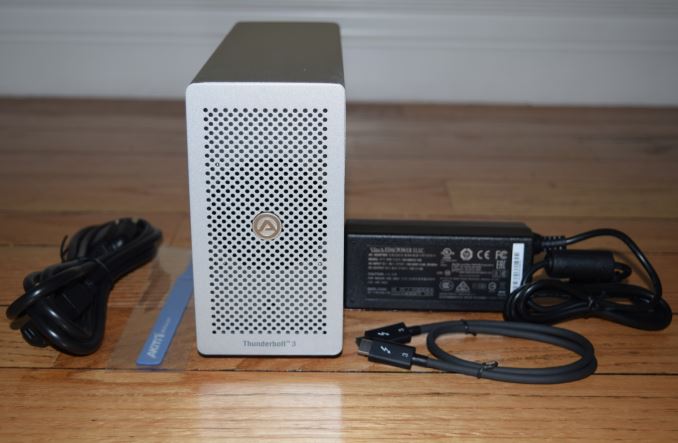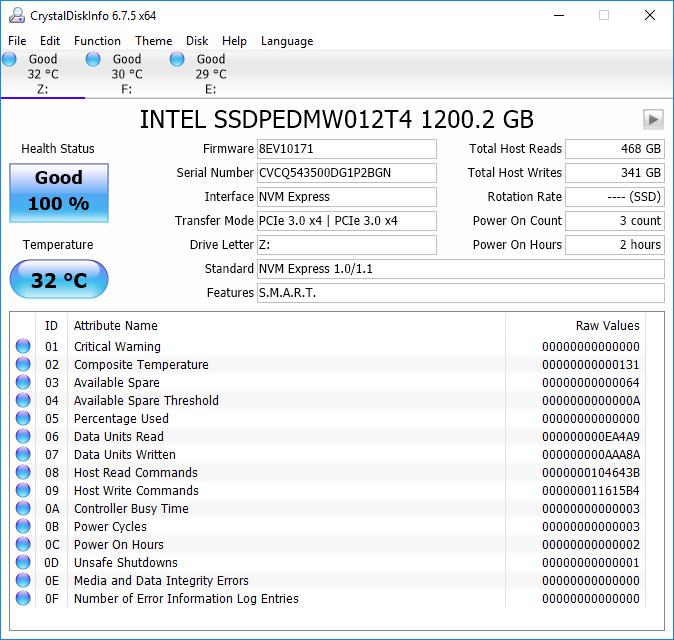AKiTiO Thunder3 PCIe SSD Thunderbolt DAS Review
by Ganesh T S on June 2, 2016 8:00 AM EST- Posted in
- Storage
- Thunderbolt
- PCIe SSD
- DAS
- Thunderbolt 3
- Akitio

The benefits of Thunderbolt 3 and its 40 Gbps link are best realized in a daisy-chain configuration involving multiple high-bandwidth I/O peripherals. The Alpine Ridge Thunderbolt 3 controller in a host connects to the CPU using a PCIe 3.0 x4 link. From the perspective of a single device that is not a huge drive array, it is likely that a PCIe 3.0 x4 SSD is best suited to fully utilize the available bandwidth. AKiTiO recently started selling their Thunder3 PCIe SSD. It puts a 1.2TB Intel SSD 750 PCIe 3.0 x4 NVMe add-in card in a standard two-port Thunderbolt 3 aluminum chassis along with a dedicated DisplayPort output.
Introduction and Setup Impressions
AKiTiO is one of the first vendors to come out with Thunderbolt 3 peripherals. We have already reviewed their first offering - the Thunder3 Duo Pro 2-bay DAS. It turned out to be a great introduction to the Thunderbolt 3 peripheral market (especially considering that it was the first one out of the door). A 2-bay DAS was never going to make the Thunderbolt 3 controller sweat, even with a couple of SATA SSDs in it. AKiTiO's second Thunderbolt 3 product, the Thunder3 PCIe SSD, goes all out in search of the performance crown.
The Thunder3 PCIe SSD is meant for desktop use and needs an external 72W power adapter (12V @ 6A). In addition to the main unit and the power adapter / cord, the package also includes a Thunderbolt 3 cable (capable of 40Gbps data transfer). A cable-tie, quick setup guide, warranty terms and a reminder to update to the latest drivers / firmware for the host PC are also included. The detailed specifications of the unit are provided in the table below.
| Akitio Thunder3 PCIe SSD Specifications | |
| Internal Storage Media | 1x Intel SSD 750 1.2TB PCIe 3.0 x4 NVMe Add-In Card |
| Interfaces | 2x Thunderbolt 3 + 1x DP 1.2 |
| RAID Modes | N/A |
| Cooling | Aluminum Chassis + Fan |
| Power Supply | 100-240V AC Switching Adapter (12V @ 6A DC) |
| Dimensions | 23.8cm x 15.2cm x 7.6cm |
| Product Page | Akitio Thunder3 PCIe SSD |
| Price | $1299 |
The gallery below takes us around the aluminum chassis and the internals. There is a LED indicator in the front panel to indicate power / access status (doesn't light up unless both the power adapter and Thunderbolt link are active). There are perforations in the front panel, and a fan directly behind it. The opening mechanism is similar to the Thunder3 Duo Pro - loosening the two tool-less screws in the back panel allows the chassis to slide out. It is possible to replace the fan, if needed. However, the installed PCIe SSD (add-in card) can't be taken out without voiding the warranty.
The main board seems to be based on the inXtron Thunderbolt 3 Hardware Development Kit. The board also contains Alpine Ridge in its dual-port form (Intel DSL6540).
Unlike the Thunder3 Duo Pro, the setup process is plug-and-play. There are no RAID buttons on the unit. However, it is necessary to install the Intel NVMe drivers in order to get the best performance out of the product. The Intel SSD Toolbox also allows users to monitor the health of the SSD 750 inside the Thunder3 PCIe SSD.
Hardware Analysis
A bus-powered enclosure would have been nice, but AKiTiO has opted to go for a more versatile solution with a dual-port design. The second port can also be used to connect another Thunderbolt 3 or USB 3.1 Gen 2 or any other Type-C peripheral. That device can sink power too - which leaves no option for AKiTiO. An external power adapter is definitely needed.
The Intel SSD 750 inside the enclosure is visible as a physical disk on the host. SMART attributes can be tracked, and, for all practical purposes, the SSD 750 is a PCIe 3.0 x4 NVMe drive connected to the host.
The specifications of the Intel SSD 750 1.2TB drive in the Thunder3 PCIe SSD are summarized in the table below.
| Intel SSD 750 Specifications | ||
| Capacity | 1.2TB | |
| Form Factor | PCIe Add-In Card (HHHL) | |
| Interface | PCIe 3.0 x4 - NVMe | |
| Controller | Intel CH29AE41AB0 | |
| NAND | Intel 20nm 128Gbit MLC | |
| Sequential Read | 2,400MB/s | |
| Sequential Write | 1,200MB/s | |
| 4KB Random Read | 440K IOPS | |
| 4KB Random Write | 290K IOPS | |
| Idle Power Consumption | 4W | |
| Read/Write Power Consumption | 10W / 22W | |
| Encryption | N/A | |
| Endurance | 70GB Writes per Day for Five Years (~128 TBW) | |
| Warranty | Five Years | |
| MSRP | $1018 | |


















28 Comments
View All Comments
samer1970 - Friday, June 3, 2016 - link
they should sell the case barebone then !patrickjp93 - Saturday, June 18, 2016 - link
They sell a $280 enclosure complete with 16x PCIe slot and a TB3 cable, so get over yourself you damn wank.tuxRoller - Thursday, June 2, 2016 - link
I know Ganesh likes doing these storage reviews but I can't help but think that they are targeting a vanishing niche.Meteor2 - Friday, June 3, 2016 - link
Well I find them interesting. Yeah it's $1,300 today but tomorrow it won't be.casperes1996 - Thursday, June 2, 2016 - link
I'm looking for a similar product for TB2 for video editing. It needs to be really fast, 256GB or bigger (if cheap, 256 and I'll make a RAID, if more expensive and really fast, 512), and I'd prefer if it weren't too big and power hungry, but I'll accept big and power hungry. Does anyone have any suggestions? I'd like it to be as cheap as possible of course, but it also needs to be fast enough to handle 4k at ProRes 4:2:2 HQ with 2, maybe occasionally 3 simultaneous streams. My current SSD doesn't always play nice when I edit video. At least I'm pretty sure that's my bottleneck, although it could also be my GPU, since it is "only" a 3,5TFLOPS card.Anyway, suggestions on SSDs for TB2?
bill44 - Friday, June 3, 2016 - link
As far as I know, TB3 is backward compatible with TB2 using the right adapter/cable.I'm ready to pull the trigger on Sonnet Fusion (this may be something you can use?), just waiting for reviews and availability.
crimsonson - Friday, June 3, 2016 - link
You have to be careful. For video editing you will age the memory quickly. This is rated for 70GB PER DAY. I could do that in minutes, especially with DNxHR/ProRes 4K capture, not even measuring renders and peripheral file like music, photos and exports.You can easily use 10 - 100 times that in a day. Easily half the age of that drive.
casperes1996 - Friday, June 3, 2016 - link
I see your point. Whilst I could also easily use 70GB in way less than a day, I do not edit on a day-to-day basis, more like twice a month, so do you think I would run into problems? if yes/maybe, what would you suggest instead?And another thing, I need something I can buy in Europe. As far as I can tell, this is not available in Europe, and neither does the Sonnet Fusion seem to be.
Thanks for the advice though
samer1970 - Friday, June 3, 2016 - link
When you buy SSD look for TBW ratingintel 750 is bad it has ONLY 219TB writes
intel P3700 however has 36500TB writes !!!
for just double the price (3700) you get 166 TIMES the writes of 750 .. so it is NOT EXPENSIVE AT ALL TO GET P3700
intel 750 is a bad choice ... for double the price you get
patrickjp93 - Saturday, June 18, 2016 - link
That's the difference between enterprise-grade hardware guarantees and consumerville stuff. Mind you, that guarantee is way below the failure time. It's just to cover Intel's butt.